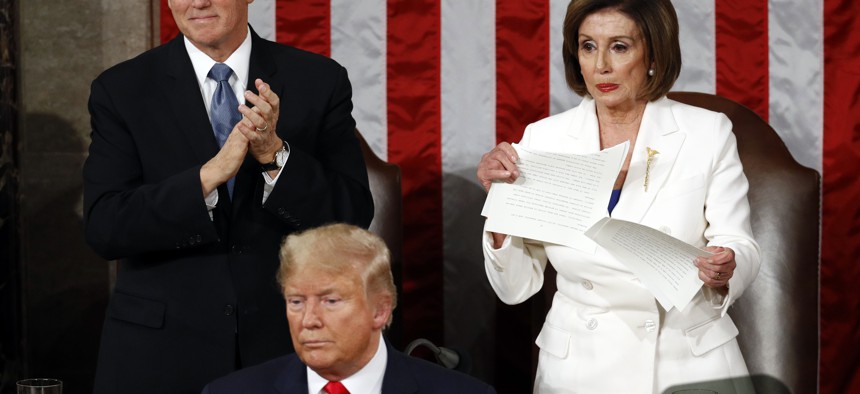
House Speaker Nancy Pelosi of Calif., tears her copy of President Donald Trump's s State of the Union address after he delivered it to a joint session of Congress on Capitol Hill in Washington, Tuesday, Feb. 4, 2020. AP Photo/Patrick Semansky
Stunts, Stagecraft and National Security in Trump’s State of the Union
Sounding like a campaign kick-off, the president leaned into one of his as-yet unfulfilled promises from the 2016 election: ending America’s “endless wars.”
In his final State of the Union speech before the 2020 presidential election, President Donald Trump sought to bolster the case for his national security bonafides on the campaign trail, touting Pentagon spending, repeating as-yet unfulfilled promises from the 2016 election to end U.S. wars in the Middle East and lingering over the successful killing of ISIS leader Abu Bakr al-Baghdadi.
The speech dispensed with the darker tone of some of Trump’s previous high-profile speeches — like his now-infamous “American carnage” inauguration speech — in favor of an “American comeback” theme that celebrated his administration's economic successes and used undisguised partisan appeals and careful stagecraft more typically seen on the campaign trail than in the annual Joint Session of Congress.
“Our country is thriving and highly respected again,” Trump told the starkly-divided body. “America's enemies are on the run, America's fortunes are on the rise, and America's future is blazing bright.”
While the killing of Baghdadi was uncontroversial, Trump also touted the drone strike that killed Iranian Gen. Qassem Soleimani in January. That strike was the target of fierce criticism on the Hill, and appeared, at least for a time, to bring the United States and Iran to the brink of war. Dozens of U.S. troops were injured in a retaliatory attack by Iranian forces later in the month.
“[Soleimani]... was actively planning new attacks,” Trump said. “Our message to the terrorists is clear: You will never escape American justice. If you attack our citizens, you forfeit your life.”
The president underscored the two strikes by inviting the families of Kayla Mueller, a humanitarian worker who was kidnapped, forcibly married, and killed by Baghdadi, and Army Staff Sergeant Christopher Hake, who was killed in 2008 by an IED believed to have been Soleimani’s work. The Pentagon has publicly blamed Iran for the IED-related deaths of roughly 600 U.S. troops during the Iraq War.
Trump repeated several often-used but exaggerated claims about the growth in NATO spending and in U.S. military spending. On NATO, the president boasted that he “raised contributions from the other NATO members by more than $400 billion, and the number of allies meeting their minimum obligations has more than doubled.” Some NATO members have responded to Trump pressure and increased defense spending levels, but there are no minimum financial obligations to the alliance. Members have made non-binding pledges to adopt defense spending levels at 2 percent of their individual gross domestic products, and those increases have not yet reached the $400 billion mark.
Trump also claimed that his administration has “invested a record-breaking $2.2 trillion dollars in the United States Military” — an oft-cited number that reflects the combined defense spending total for his three years in office.
And he leaned into one of his most resonant promises from the 2016 election: ending America’s so-called “endless wars” in the Middle East. Trump on Tuesday night promised that the administration is “working” to end engagements in Afghanistan and elsewhere. He claimed “tremendous progress” in Afghanistan, highlighting that “peace talks are now underway.”
“I am not looking to kill hundreds of thousands of people in Afghanistan, many of them totally innocent. It is also not our function to serve other nations as a law enforcement agencies,” Trump said. “These are warfighters, the best in the world, and they either want to fight to win or not fight at all.”
Trump did not offer an alternative policy direction to the current South Asia strategy or Afghanistan war effort that might speed the effort to “bring home” U.S. troops. Trump in September abruptly called off peace talks between the U.S. and the Taliban after the Taliban killed an American soldier. Those talks, led by U.S. Special Envoy Zalmay Khalilzad, have since been restarted. Khalilzad on Saturday told Afghan President Ashraf Ghani that no significant progress has been made, according to a statement from Ghani’s office. The Taliban carried out a record number of attacks in Afghanistan during the last quarter of 2019.
Trump has long expressed ambivalence about the U.S. wars in Afghanistan, Syria and elsewhere. But other than a withdrawal of fewer than 2,000 troops in Syria, U.S. service-members are not actually “coming home” under Trump.
In one of the most dramatic moments of the speech, Trump announced the surprise return of a deployed service-member, who was reunited with his wife and two children in the gallery of the House to chants of “USA” from lawmakers.
Although the moment received applause from Democratic lawmakers, some critics blasted the White House for making made-for-TV use of military personnel and families as political props during the speech.
In many ways, the speech echoed the structure of President Barack Obama’s 2012 State of the Union speech, laying out his security accomplishments as he faced a looming reelection campaign.
Still, the speech came at a historically fraught moment for Trump. He has been impeached by the House, although he is expected to be acquitted by the Senate on Wednesday. But impeachment was virtually absent from the president’s speech, which also came at a moment of triumph: Trump’s job approval rating is at a personal best of 49 percent, according to a new Gallup poll that attributes the spike to both impeachment and the recent military action in Iran. (Americans approve of the strike on Soleimani 53 percent to 45 percent.)
And the Democratic caucuses in Iowa ended in a humiliating disaster for the Democrats on Monday night, when human error and technology glitches made it impossible to announce the winner on Monday night.
In a signal of the starkly partisan mood on Capitol Hill, the speech was received along deeply partisan lines. Minority Democratic members audibly booed and murmured throughout the speech, when tradition dictates opponents should sit silent. Following the speech, House Speaker Nancy Pelosi, D-Calif., tore her copy of the speech in half.
In the House chamber during his speech, congressional Republicans chanted: “Four more years! Four more years!”




